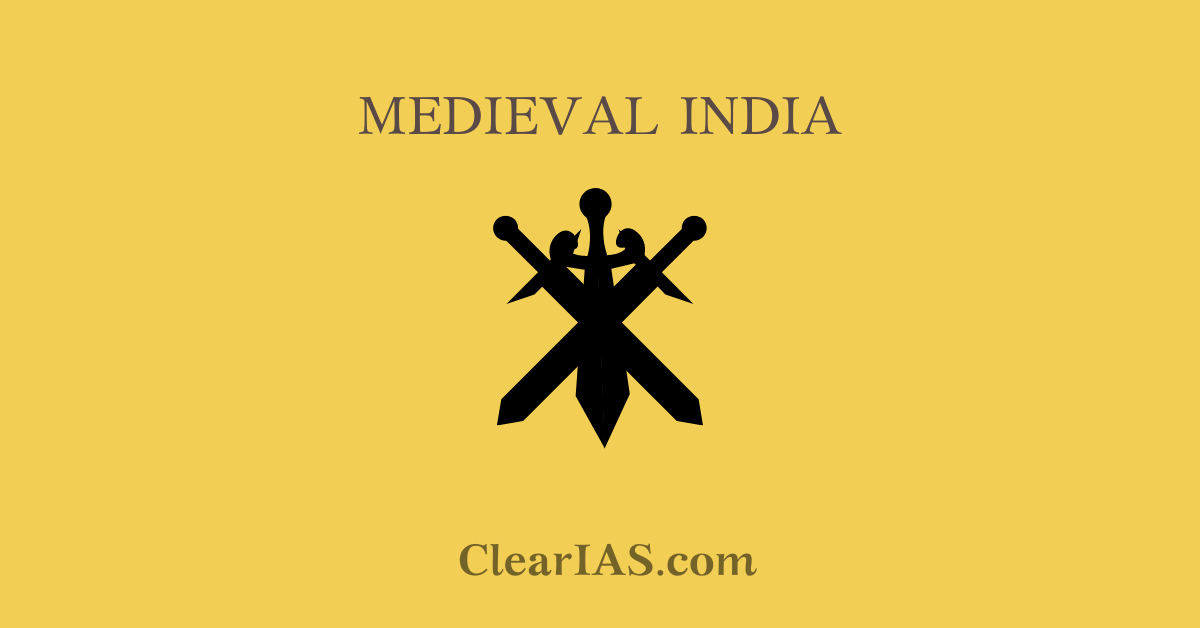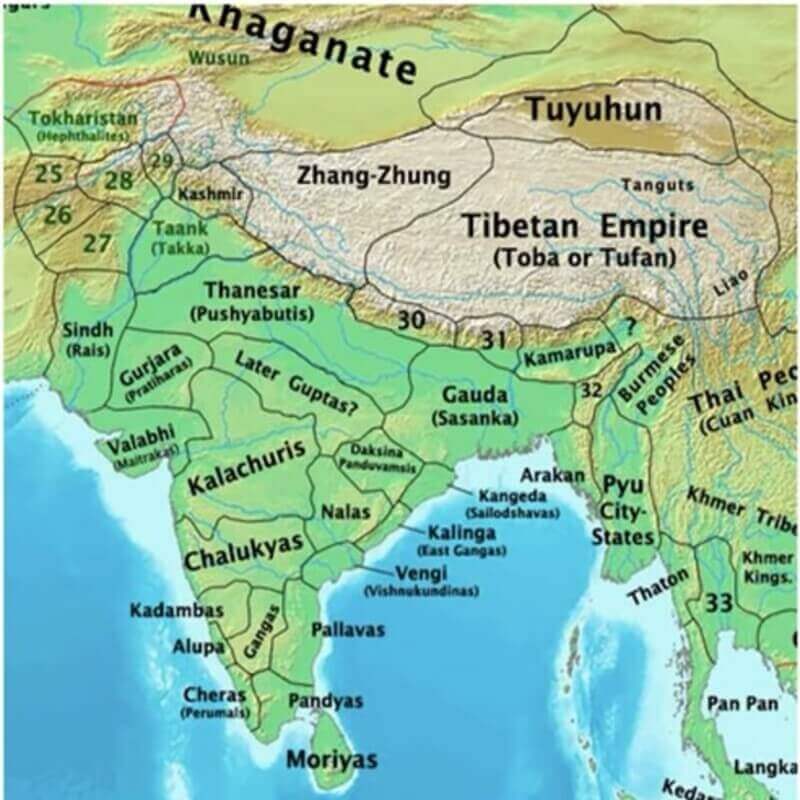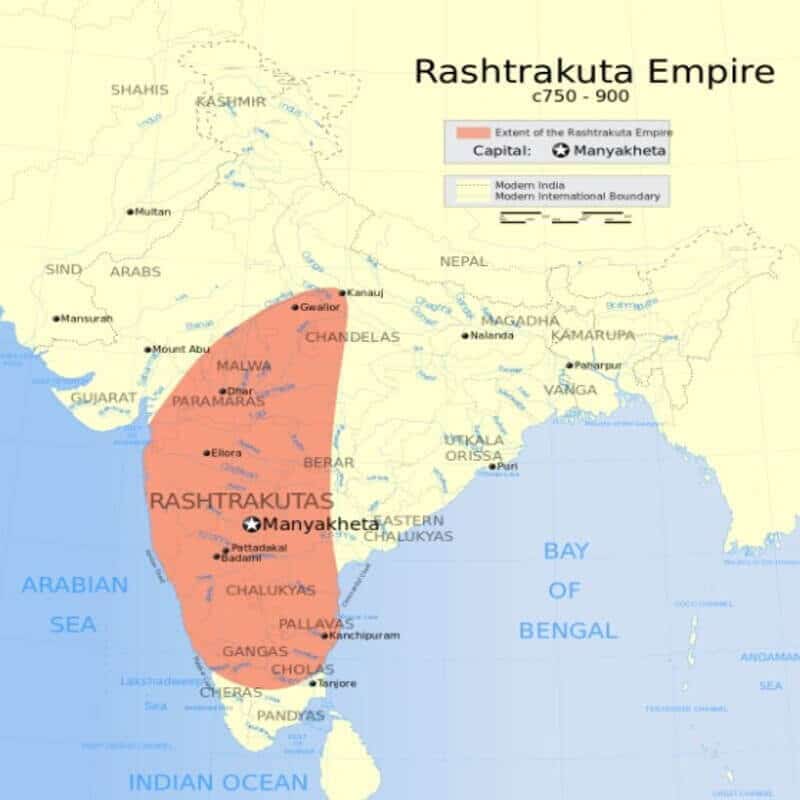
The beginning of the medieval era in India is marked by the rise of Rashtrakutas in the Deccan region. Read here to know the important events that marked the beginning of the medieval period.
At the end of the ancient era, the Indian landscape is dotted with numerous small kingdoms.
- To the north, Harsha’s Thanesar was there.
- The Kalabhras kingdom in southern India (dark aged of the south) crumbled
- The ancient classical kingdoms of Pallavas and Pandyas began to rise again.
- The Chalukyas of Badami ruled southern and central India from the 6th to 12th century CE. Their reign saw Kannada and Telugu literature thriving, along with magnificent Chalukyan architecture.
- To the northwest, the Chachas dynasty was ruling in the Sindh region from around 700 CE.

The Chalukyan era saw many significantly important architectural marvels like the Bhoothnath group of temples in Badami, Karnataka.
In northern India, there was no political unity for about five centuries after the death of Harsha.
- Numerous states were fighting amongst each other and constantly changing frontiers.
- Kashmir, Gandhara, Sind, Gujarat, Kanauj, Ajmer, Malwa, Bengal, and Assam were different kingdoms that became powerful at different times.
- In the early 8th century, Kashmir was dominant and ruled almost till present-day Uttar Pradesh.
- Later Palas of Bengal, and finally Pratihars became the powerful rulers of north India.
The period of 750 to 1000 CE, thus came to be known ‘The Age of 3 Empires’:
- Palas of Bengal
- Gurjara-Pratiharas of Ujjaain/Kanauj
- Rashtrakutas of Manyakheta
There was a struggle for domination amongst them which came to be known as the Tripartite struggle in the Kannauj Triangle.

Each of these kingdoms vied for control of the territory of the Ganga-Yamuna doab and the Kanauj region.
- The Kannauj region was sought after because of its rich trade center, fertile lands for agriculture, and history of hosting significant powerful kingdoms.
The Palas and Pratiharas also clashed over the region from Benaras to south Bihar which was also rich in resources and well developed in culture and education.
In the end, the Gurjara-Pratiharas won the Tripartite struggle and established themselves over the northern Indian region.
The rise of Rashtrakutas

The Rashtrakutas came into power in the Deccan in 753 CE.
Earlier, the Elichpur clan of Rashtrakutas were the feudatories of the Chalukyas of Badami.
In 753 CE, Dantidurga overthrew the Chalukyan king Kirtivarman II to establish the kingdom of Rashtrakutas of Manyakheta.
They had their capital and Manyakhet or Mankheda near Gulbarga (present-day Sholapur).
The Rashtrakutas fought constantly with their neighboring kingdoms of:
- Chalukyas of Vengi in the east (in modern Andhra Pradesh)
- Pallavas of Kanchi
- Pandyas of Madurai in the south
Rashtrakutas ruled from 753 to 982 CE, and their most powerful kings were:
- Dantidurga (735-756): Founder of the kingdom
- Dhruva Dharavarsha (780-793): He defeated Gurjara-Pratihara King Vatsyaraja, the Pallavas of Kanchi and the Pala King Dharmapala of Bengal.
- Govinda III (793-814)
- Amoghavarsha (814-878): He was one of the most powerful and longest ruling monarch of the dynasty.
- Indra III (914-929)
- Krishna III (939-967)
- Karka (972-973): The last Rakshtrakuta King defeated by Tailapa, Chalukya king of Kalyani
Govinda III
Reign of Govinda III saw numerous successful and important battles:
- He had a successful expedition against Pratihara King Nagabhatta of Kanauj
- He led the annexation of Malwa
- Govind III turned south and threatened the Pallavas, Pandyas, and Cholas.
- Gangas of Karnataka were defeated
- King of Sri Lanka was defeated, captured, and brought over as a prisoner to Manyakhet
Govinda III extended the kingdom to its maximum extent during his reign.
Amoghavarsha (814-878)
Amoghavrsha inherited a well-established large kingdom, hence turning his attention to religion and literature.
- He was the author of the first Kannada book on grammar and poetics- Kavirajamarga.
- He commissioned the famous temples of Jaina Narayana temple in Pattadakal (which is also a UNESCO world heritage site).
- Abu Sulaiman, the Arab traveler visited his capital in 851CE. He says the Rashtrakuta empire is one of the four great empires of the world.
By the end of his reign, many rebellions started in the kingdom making it a weak period of the dynasty.
Indra III (915-927)
- He was the grandson of Amoghavarsha who re-established the weakening empire.
- He defeated the Pratihara ruler Mahipala and sacked Kannauj which catapulted him to be the most powerful ruler of that time.
Krishna III (939-967)
- Krishna IÌI fought against the Paramaras of Malwa and eastern Chalukyas of Vengi.
- He also launched a campaign against the Cholas of Tanjore who had replaced the Pallavas of Kanchi.
- In 949, Krishna III defeated Chola ruler Parantaka I and annexed the north of the Chola kingdom.
- Krishna III campaigned down to Rameswaram and set up a pillar of victory and also built a temple there.
After his death, all opponents united and attacked the Rashtrakutas. In 972, the capital Malkhed was sacked and burned. This marked the end of the Rashtrakuta kingdom.
Administration of Rashtrakutas
Directly administered areas of the Rashtrakuta kingdom were divided into three levels:
- Rashtra (provinces)
- Visaya (district)
- Bhukti
- The Head of a Rashtra was the Rashtrapati/governor. He performed the same functions as uparika did in the Pala and Pratihara kingdoms (Uparika collected land revenue and maintained law with the help of an army).
- Visyapati were the heads of the Visayas who handled the administrative duties.
- Bhogapati controlled the bhukti which consisted of 50-70 villages.
- The village administration was in charge of managing local schools, tanks, temples, and roads.
- Law and order in the towns were maintained by the Kosta pala or kotwal.
- Hereditary revenue officers- gavundas or Desa gramakutas had the same functions as the later Deshmukh and Deshpande of Maharashtra. But as these hereditary offices grew, village committees became weaker.
- Central rulers found it challenging to control the hereditary officials/nobles which was the mark of feudalism.
Rashtrakuta Art and culture
- Rashtrakutas promoted Shaivism, Vaishnavism, and Jainism.
- Many of the Hindu and Buddhist Caves at Ellora were built by Rashtrakuta Kings.
- The famous 9th-century rock-cut temple of Shiva, the Kailash temple at Ellora was built by Krishna I.
- Cave no. 5, the Dahsharatha cave in Ellora was also built by Rashtrakutas.
- Elephanta caves were restored by the Rashtrakuta kings in the 8th century CE.
- The famous poet Savayambhu and his son were patronized by the Rahshtrakutas, and a writer Medhatiti wrote the dharma shastras (law books).
- The three gems of ancient Kannada literature -Pampa, Ranna, and Ponna were patronized by Rashtrkuta kings. They wrote the following books in Kannada:
- Pampa- Adipurana, vikramarjuna vijaya
- Ranna- Gadhayudha
- Ponna- Shantipurana
- Mahaveeracharya, a mathematician, wrote Ganithasarasangraha in Sanskrit.
- Halayudha wrote Kavirahasya in Sanskrit.
- Overall, the Kannada language received great patronage and golden age in this era.
- The court hosted various musicians and dancers, and women did not veil their faces
- Rashtrakutas also allowed Muslim traders to settle in India and permitted Islam to be preached.
- Muslims had their own headmen and separate large mosques in many coastal towns.
- These tolerant policies helped foreign trade with Arabs.






Leave a Reply